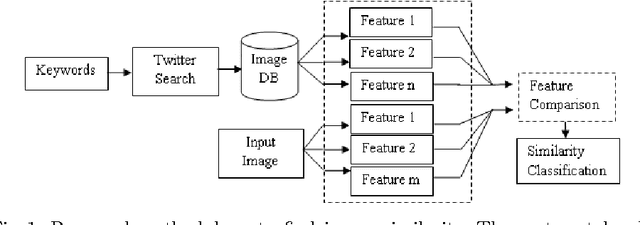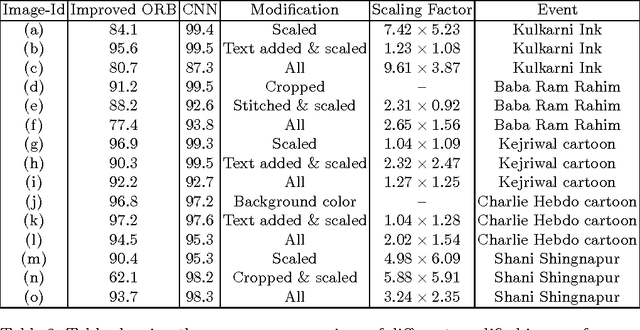A V Subramanyam
Boosting Weak Positives for Text Based Person Search
Jan 30, 2025



Abstract:Large vision-language models have revolutionized cross-modal object retrieval, but text-based person search (TBPS) remains a challenging task due to limited data and fine-grained nature of the task. Existing methods primarily focus on aligning image-text pairs into a common representation space, often disregarding the fact that real world positive image-text pairs share a varied degree of similarity in between them. This leads models to prioritize easy pairs, and in some recent approaches, challenging samples are discarded as noise during training. In this work, we introduce a boosting technique that dynamically identifies and emphasizes these challenging samples during training. Our approach is motivated from classical boosting technique and dynamically updates the weights of the weak positives, wherein, the rank-1 match does not share the identity of the query. The weight allows these misranked pairs to contribute more towards the loss and the network has to pay more attention towards such samples. Our method achieves improved performance across four pedestrian datasets, demonstrating the effectiveness of our proposed module.
Keypoint Aware Masked Image Modelling
Jul 18, 2024Abstract:SimMIM is a widely used method for pretraining vision transformers using masked image modeling. However, despite its success in fine-tuning performance, it has been shown to perform sub-optimally when used for linear probing. We propose an efficient patch-wise weighting derived from keypoint features which captures the local information and provides better context during SimMIM's reconstruction phase. Our method, KAMIM, improves the top-1 linear probing accuracy from 16.12% to 33.97%, and finetuning accuracy from 76.78% to 77.3% when tested on the ImageNet-1K dataset with a ViT-B when trained for the same number of epochs. We conduct extensive testing on different datasets, keypoint extractors, and model architectures and observe that patch-wise weighting augments linear probing performance for larger pretraining datasets. We also analyze the learned representations of a ViT-B trained using KAMIM and observe that they behave similar to contrastive learning with regard to its behavior, with longer attention distances and homogenous self-attention across layers. Our code is publicly available at https://github.com/madhava20217/KAMIM.
Resource Efficient Perception for Vision Systems
May 12, 2024



Abstract:Despite the rapid advancement in the field of image recognition, the processing of high-resolution imagery remains a computational challenge. However, this processing is pivotal for extracting detailed object insights in areas ranging from autonomous vehicle navigation to medical imaging analyses. Our study introduces a framework aimed at mitigating these challenges by leveraging memory efficient patch based processing for high resolution images. It incorporates a global context representation alongside local patch information, enabling a comprehensive understanding of the image content. In contrast to traditional training methods which are limited by memory constraints, our method enables training of ultra high resolution images. We demonstrate the effectiveness of our method through superior performance on 7 different benchmarks across classification, object detection, and segmentation. Notably, the proposed method achieves strong performance even on resource-constrained devices like Jetson Nano. Our code is available at https://github.com/Visual-Conception-Group/Localized-Perception-Constrained-Vision-Systems.
Image Synthesis with Graph Conditioning: CLIP-Guided Diffusion Models for Scene Graphs
Jan 26, 2024Abstract:Advancements in generative models have sparked significant interest in generating images while adhering to specific structural guidelines. Scene graph to image generation is one such task of generating images which are consistent with the given scene graph. However, the complexity of visual scenes poses a challenge in accurately aligning objects based on specified relations within the scene graph. Existing methods approach this task by first predicting a scene layout and generating images from these layouts using adversarial training. In this work, we introduce a novel approach to generate images from scene graphs which eliminates the need of predicting intermediate layouts. We leverage pre-trained text-to-image diffusion models and CLIP guidance to translate graph knowledge into images. Towards this, we first pre-train our graph encoder to align graph features with CLIP features of corresponding images using a GAN based training. Further, we fuse the graph features with CLIP embedding of object labels present in the given scene graph to create a graph consistent CLIP guided conditioning signal. In the conditioning input, object embeddings provide coarse structure of the image and graph features provide structural alignment based on relationships among objects. Finally, we fine tune a pre-trained diffusion model with the graph consistent conditioning signal with reconstruction and CLIP alignment loss. Elaborate experiments reveal that our method outperforms existing methods on standard benchmarks of COCO-stuff and Visual Genome dataset.
Language Guided Adversarial Purification
Sep 19, 2023



Abstract:Adversarial purification using generative models demonstrates strong adversarial defense performance. These methods are classifier and attack-agnostic, making them versatile but often computationally intensive. Recent strides in diffusion and score networks have improved image generation and, by extension, adversarial purification. Another highly efficient class of adversarial defense methods known as adversarial training requires specific knowledge of attack vectors, forcing them to be trained extensively on adversarial examples. To overcome these limitations, we introduce a new framework, namely Language Guided Adversarial Purification (LGAP), utilizing pre-trained diffusion models and caption generators to defend against adversarial attacks. Given an input image, our method first generates a caption, which is then used to guide the adversarial purification process through a diffusion network. Our approach has been evaluated against strong adversarial attacks, proving its effectiveness in enhancing adversarial robustness. Our results indicate that LGAP outperforms most existing adversarial defense techniques without requiring specialized network training. This underscores the generalizability of models trained on large datasets, highlighting a promising direction for further research.
IIITD-20K: Dense captioning for Text-Image ReID
May 08, 2023



Abstract:Text-to-Image (T2I) ReID has attracted a lot of attention in the recent past. CUHK-PEDES, RSTPReid and ICFG-PEDES are the three available benchmarks to evaluate T2I ReID methods. RSTPReid and ICFG-PEDES comprise of identities from MSMT17 but due to limited number of unique persons, the diversity is limited. On the other hand, CUHK-PEDES comprises of 13,003 identities but has relatively shorter text description on average. Further, these datasets are captured in a restricted environment with limited number of cameras. In order to further diversify the identities and provide dense captions, we propose a novel dataset called IIITD-20K. IIITD-20K comprises of 20,000 unique identities captured in the wild and provides a rich dataset for text-to-image ReID. With a minimum of 26 words for a description, each image is densely captioned. We further synthetically generate images and fine-grained captions using Stable-diffusion and BLIP models trained on our dataset. We perform elaborate experiments using state-of-art text-to-image ReID models and vision-language pre-trained models and present a comprehensive analysis of the dataset. Our experiments also reveal that synthetically generated data leads to a substantial performance improvement in both same dataset as well as cross dataset settings. Our dataset is available at https://bit.ly/3pkA3Rj.
Certified Zeroth-order Black-Box Defense with Robust UNet Denoiser
Apr 13, 2023



Abstract:Certified defense methods against adversarial perturbations have been recently investigated in the black-box setting with a zeroth-order (ZO) perspective. However, these methods suffer from high model variance with low performance on high-dimensional datasets due to the ineffective design of the denoiser and are limited in their utilization of ZO techniques. To this end, we propose a certified ZO preprocessing technique for removing adversarial perturbations from the attacked image in the black-box setting using only model queries. We propose a robust UNet denoiser (RDUNet) that ensures the robustness of black-box models trained on high-dimensional datasets. We propose a novel black-box denoised smoothing (DS) defense mechanism, ZO-RUDS, by prepending our RDUNet to the black-box model, ensuring black-box defense. We further propose ZO-AE-RUDS in which RDUNet followed by autoencoder (AE) is prepended to the black-box model. We perform extensive experiments on four classification datasets, CIFAR-10, CIFAR-10, Tiny Imagenet, STL-10, and the MNIST dataset for image reconstruction tasks. Our proposed defense methods ZO-RUDS and ZO-AE-RUDS beat SOTA with a huge margin of $35\%$ and $9\%$, for low dimensional (CIFAR-10) and with a margin of $20.61\%$ and $23.51\%$ for high-dimensional (STL-10) datasets, respectively.
Meta Generative Attack on Person Reidentification
Jan 16, 2023Abstract:Adversarial attacks have been recently investigated in person re-identification. These attacks perform well under cross dataset or cross model setting. However, the challenges present in cross-dataset cross-model scenario does not allow these models to achieve similar accuracy. To this end, we propose our method with the goal of achieving better transferability against different models and across datasets. We generate a mask to obtain better performance across models and use meta learning to boost the generalizability in the challenging cross-dataset cross-model setting. Experiments on Market-1501, DukeMTMC-reID and MSMT-17 demonstrate favorable results compared to other attacks.
SenseNet: Deep Learning based Wideband spectrum sensing and modulation classification network
Dec 11, 2019



Abstract:Next generation networks are expected to operate in licensed, shared as well as unlicensed spectrum to support spectrum demands of a wide variety of services.Due to shortage of radio spectrum, the need for communication systems(like cognitive radio) that can sense wideband spectrum and locate desired spectrum resources in real time has increased.Automatic modulation classifier (AMC) is an important part of wideband spectrum sensing (WSS) as it enables identification of incumbent users transmitting in the adjacent vacant spectrum.Most of the proposed AMC work on Nyquist samples which need to be further processed before they can be fed to the classifier.Working with Nyquist sampled signal demands high rate ADC and results in high power consumption and high sensing time which is unacceptable for next generation communication systems.To overcome this drawback we propose to use sub-nyquist sample based WSS and modulation classification. In this paper, we propose a novel architecture called SenseNet which combines the task of spectrum sensing and modulation classification into a single unified pipeline.The proposed method is endowed with the capability to perform blind WSS and modulation classification directly on raw sub-nyquist samples which reduces complexity and sensing time since no prior estimation of sparsity is required. We extensively compare the performance of our proposed method on WSS as well as modulation classification tasks for a wide range of modulation schemes, input datasets, and channel conditions.A significant drawback of using sub-nyquist samples is reduced performance compared to systems that employ nyquist sampled signal.However,we show that for the proposed method,the classification accuracy approaches to Nyquist sampling based deep learning AMC with an increase in signal to noise ratio.
PicHunt: Social Media Image Retrieval for Improved Law Enforcement
Sep 15, 2016



Abstract:First responders are increasingly using social media to identify and reduce crime for well-being and safety of the society. Images shared on social media hurting religious, political, communal and other sentiments of people, often instigate violence and create law & order situations in society. This results in the need for first responders to inspect the spread of such images and users propagating them on social media. In this paper, we present a comparison between different hand-crafted features and a Convolutional Neural Network (CNN) model to retrieve similar images, which outperforms state-of-art hand-crafted features. We propose an Open-Source-Intelligent (OSINT) real-time image search system, robust to retrieve modified images that allows first responders to analyze the current spread of images, sentiments floating and details of users propagating such content. The system also aids officials to save time of manually analyzing the content by reducing the search space on an average by 67%.
 Add to Chrome
Add to Chrome Add to Firefox
Add to Firefox Add to Edge
Add to Edge